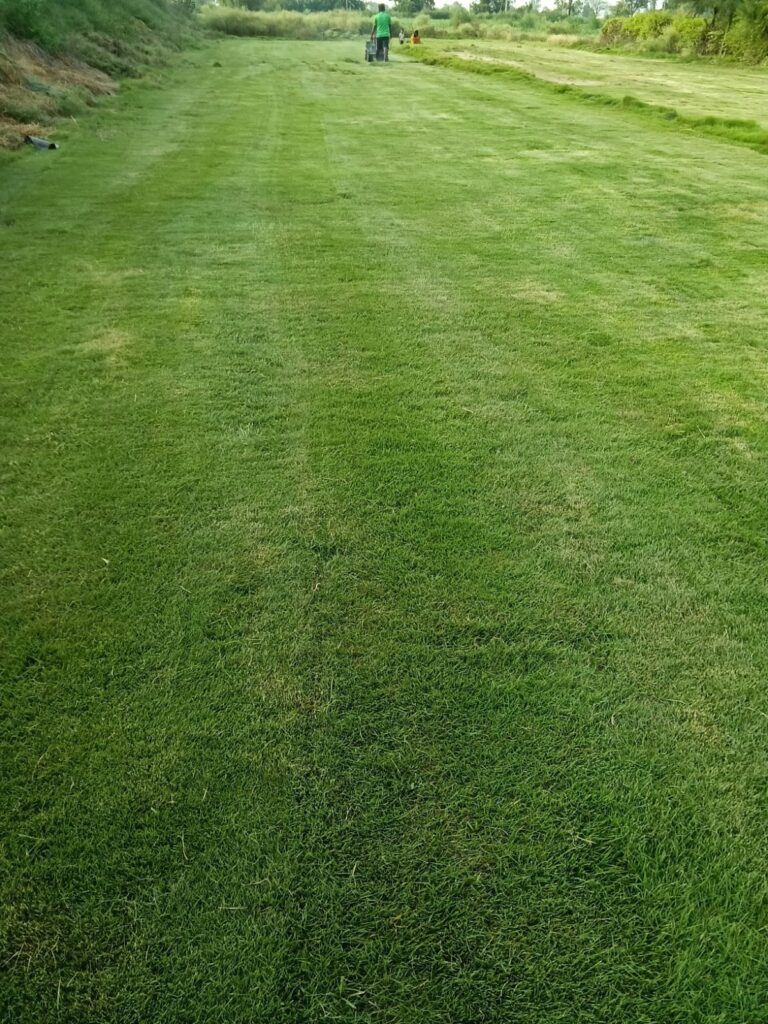Lawn Care Tips for Punjab’s Rainy & Cold Weather
Introduction
Taking care of a lawn in Punjab isn’t always simple. Between the heavy rains of monsoon and the chilly winters, lawns face a lot of stress. If you’ve ever wondered why your grass looks patchy, yellow, or diseased during these seasons, the weather is often the main culprit. With a little planning and the right techniques, you can keep your lawn lush and green throughout the year.
Understanding Punjab’s Weather Conditions
Punjab experiences two major weather challenges for lawns:
-
Rainy season (June–September): Heavy downpours can cause waterlogging, fungal issues, and rapid weed growth.
-
Winter (November–February): Cold winds and occasional frost can weaken grass roots and stunt growth.
Knowing how the weather affects your lawn is the first step to maintaining it.
Choosing the Right Grass for Punjab
Not all grass types survive Punjab’s weather equally.
-
Best for Rainy Season: Bermuda grass and Doob grass (Cynodon dactylon) handle excess moisture well.
-
Best for Winters: Ryegrass and Zoysia grass show good tolerance against cold and frost.
Mixing seasonal grasses is a smart way to maintain year-round greenery.
Soil Preparation Before the Rainy Season
Healthy lawns begin with healthy soil.
-
Soil Aeration: Loosen compact soil before rains to improve drainage.
-
Organic Matter: Mix compost, cow dung manure, or leaf mulch to enrich the soil and improve water absorption.
Drainage Solutions for Rainy Weather
Nothing kills grass faster than stagnant water.
-
French Drains or Channels: Help redirect excess rainwater.
-
Gentle Slopes: Ensure water flows away from the lawn instead of pooling.
Fertilization in Rainy and Cold Weather
-
Monsoon Fertilization: Apply potassium-rich fertilizers to strengthen roots against fungal attacks.
-
Winter Fertilization: Use slow-release nitrogen fertilizers to keep grass nourished during dormancy.
Watering Strategies
-
During Monsoon: Skip watering on rainy days to avoid soggy roots.
-
During Winter: Water in the morning to prevent frost damage at night.
Weed and Pest Management
-
Rainy Season Weeds: Parthenium, crabgrass, and nutgrass often spread rapidly.
-
Control Measures: Hand weeding, organic herbicides, or mulching.
-
Pest Watch: Monitor for earthworms, grubs, and fungal gnats in damp conditions.
Lawn Mowing Practices
-
In Monsoon: Keep grass slightly taller (about 3 inches) to protect roots.
-
In Winter: Mow less frequently since growth slows down.
Dealing with Lawn Diseases
-
Monsoon Diseases: Fungal infections like brown patch, dollar spot, and rust are common.
-
Cold Weather Issues: Snow mold and root rot may appear in extreme cold.
Use fungicides only when necessary, and rely more on proper drainage and aeration.
Protecting Grass During Frost
Punjab winters can sometimes surprise you with frost.
-
Frost Blankets or Sheets: Cover grass on very cold nights.
-
Mulching: Spread organic mulch around the lawn edges to insulate roots.

Seasonal Lawn Maintenance Calendar for Punjab
-
March–May: Fertilize and aerate soil before monsoon.
-
June–September: Focus on drainage, weed removal, and pest control.
-
October–December: Overseed with cold-tolerant grasses.
-
January–February: Light watering, frost protection, and minimal mowing.
Eco-Friendly Lawn Care Tips
-
Natural Fertilizers: Use neem cake, compost tea, and cow dung manure.
-
Rainwater Harvesting: Collect rainwater for later use during dry winter months.
-
Biological Pest Control: Introduce natural predators like ladybugs to control pests.
Common Mistakes in Punjab’s Lawn Care
-
Overwatering during the rainy season.
-
Using high nitrogen fertilizer in monsoon (leads to fungal outbreaks).
-
Neglecting frost protection in winter.
-
Mowing too short before rains.
Conclusion
Punjab’s rainy and cold weather may be tough on lawns, but with the right care, your grass can thrive year-round. Choosing the right grass, preparing soil, managing water, and protecting against frost are the keys to success. With consistent seasonal care, your lawn can stay green, healthy, and beautiful no matter the weather.
For readers across the state, our detailed guide on Natural Lawn Grass in Punjab
FAQs
1. Which grass is best for Punjab’s winters?
Ryegrass and Zoysia are excellent choices for cold weather.
2. How do I prevent fungal infections during the monsoon?
Improve drainage, avoid overwatering, and apply potassium-rich fertilizers.
3. Can I water my lawn at night in winter?
No, always water in the morning to avoid frost damage.
4. How often should I mow during the rainy season?
Once a week is enough, but don’t cut grass too short.
5. What is the best natural fertilizer for Punjab lawns?
Compost, neem cake, and cow dung manure work very well.
Last Updated on 3 months ago by Anjali Mehra Ph.D. in Horticulture (Punjab Agricultural University)
- Grass Types that Survive Frost & Snow (Uttarakhand-Specific) - December 6, 2025
- Low-Water Grass Varieties for Hilly Homes in Uttarakhand - December 1, 2025
- Mexican Grass vs Bermuda Grass – Which is Best for Indian Lawns? - November 28, 2025
